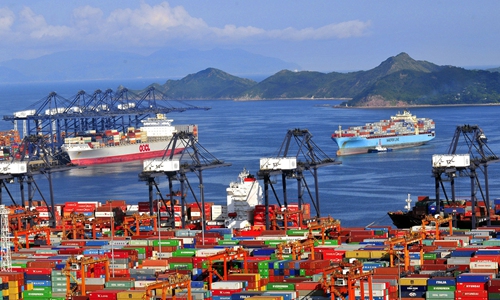China's industrial output expands 5.6%
Monday, December 16, 2019, 14:11
By Xinhua
An industrial robot is displayed at the fourth China (Guangdong) International Internet Plus Expo in Foshan, Guangdong province. (PHOTO / XINHUA)
BEIJING — China's value-added industrial output, an important economic indicator, expanded 5.6 percent year-on-year in the first 11 months,
the National Bureau of Statistics (NBS) said Monday.
The growth rate was flat with that in the first 10 months, according to the bureau.
In November alone, industrial output climbed 6.2 percent, up from 4.7 percent registered in October.
China's industrial output, officially called industrial value added, is used to measure the activity of designated large enterprises with annual business turnover of at least 20 million yuan (about US$2.86 million).
ALSO READ: China's industrial output expands 5.6%
The November output growth indicated stable industrial development and upgrading, NBS spokesman Fu Linghui told a press conference.
In a breakdown by ownership, the output of state-controlled enterprises climbed 3.7 percent last month, that of joint-stock companies went up 7 percent, and that of overseas-funded enterprises rose by 3.2 percent.
Private companies logged an 8.9-percent output increase as a slew of government measures supporting small and medium-sized enterprises took effect, said Fu.
The production and supply of electricity, thermal power, gas and water reported a year-on-year increase of 6.7 percent in November, the fastest among the three major sectors, which also include mining and manufacturing.
Manufacturing output rose 6.3 percent year-on-year, and mining output rose 5.7 percent.
High-tech manufacturing saw an output increase of 8.9 percent last month, representing continued structural improvement from mere expansion to quality-oriented growth, said Fu.
Tech-intensive and eco-friendly gadgets like smart watches and charging poles are becoming powerful engines of industrial growth, according to Fu.
China's industry development, bolstered by the country's considerable market size and innovation, and will remain a major driver for future economic growth, said Fu.
China's fixed-asset investment grew 5.2 percent year on year in the first 11 months of 2019, flat with the rate during the January-October period, official data showed
Fixed-asset investment up 5.2%
China continued to see steady growth in fixed-asset investment (FAI), boosted by robust high-tech investment and improving trend in some weak areas, official data showed Monday.
The FAI grew 5.2 percent year-on-year in the first 11 months of 2019, flat with the rate during the January-October period, according to the National Bureau of Statistics (NBS).
In the first 11 months, the FAI amounted to 53.37 trillion yuan (about US$7.63 trillion).
On a month-on-month basis, FAI rose 0.42 percent.
Investment by the state sector went up 6.9 percent during the period, while private-sector investment increased 4.5 percent, 0.1 percentage points higher than that in the first 10 months.
Investment in high-tech manufacturing and services surged 14.8 percent and 13.1 percent year-on-year, respectively.
"Investment has maintained steady growth, with that in some weak areas posting relatively fast growth," the NBS said in a statement.
Investment in the primary industry edged down 0.1 percent, while that in the secondary and tertiary industries rose 2.4 percent and 6.7 percent, respectively.
Investment in social undertakings, including education, culture and sports gained 12.6 percent, while that in environmental protection jumped 36.3 percent.
The FAI includes capital spent on infrastructure, property, machinery and other physical assets.
The figures are among a series of indicators released by the NBS, including industrial production and retail sales, which show that the economy remains on a stable track.
In this undated photo, customers visit a newly opened Hema Fresh store in Xi'an, Shaanxi province, in April, which provides more than 6,000 kinds of products imported from around 100 countries. (PHOTO PROVIDED TO CHINA DAILY)
Retail sales up 8%
BEIJING — China's retail sales of consumer goods rose 8 percent year-on-year in the first 11 months of 2019, the National Bureau of Statistics (NBS) said Monday.
The indicator of consumption dipped from an increase of 8.1 percent registered in the first 10 months.
Sales of the consumer goods totaled 37.29 trillion yuan (about US$5.33 trillion) from January to November. Excluding sales of automobiles, the growth rate reached 9 percent during the period.
In November alone, total amount of retail sales expanded 8 percent to hit 3.81 trillion yuan, with the pace of growth 0.8 percentage points faster from October.
In the first 11 months, retail sales in rural areas rose 9 percent, outpacing the 7.9-percent expansion in urban areas.
Online sales continued to report robust expansion, with a year-on-year increase of 16.6 percent to stand at 9.5 trillion yuan, NBS data showed.
In terms of consumption types, the revenue of the catering industry gained 9.4 percent year-on-year to 4.19 trillion yuan, while the retail sales of commodities climbed 7.9 percent year-on-year.
China pledged to promote consumption upgrading and give play to the underpinning role of consumption.
China's investment in property development grew 10.2 percent year-on-year in the first 11 months, down from 10.3 percent for the first 10 months, NBS data showed
Property investment up 10.2%
China's investment in property development grew 10.2 percent year-on-year in the first 11 months, down from 10.3 percent for the first 10 months, the National Bureau of Statistics (NBS) said Monday.
The total property investment during the period stood at 12.13 trillion yuan (about 1.7 trillion U.S. dollars), the NBS said.
The investment in residential buildings went up 14.4 percent year-on-year to 8.92 trillion yuan in the first 11 months, with the pace of growth decelerating 0.2 percentage points from the first 10 months.
Commercial housing sales in terms of floor area totaled 1.49 billion square meters from January to November, up 0.2 percent year-on-year, 0.1 percentage points higher than the January-October growth.
In the first 11 months, commercial housing sales in terms of value gained 7.3 percent to 13.9 trillion yuan, unchanged from the growth rate in the first 10 months.
READ MORE: China's private, smaller firms report faster industrial growth
Customers check out real estate models at a property firm in Langfang, Hebei province. (PHOTO PROVIDED TO CHINA DAILY)
Employment stable
China's job market remained generally stable in the first 11 months of the year, the National Bureau of Statistics (NBS) said Monday.
A total of 12.79 million new urban jobs were created during the period, exceeding this year's target of creating over 11 million urban jobs, according to the bureau.
The surveyed urban unemployment rate nationwide stood at 5.1 percent last month, unchanged from the rate in October.
The surveyed unemployment rate among the people aged between 25 and 59, the majority of the labor market, stayed unchanged at 4.6 percent last month.
Meanwhile, the surveyed urban unemployment rate of 31 major cities was 5.1 percent in November, flat with that in October, said the NBS.
The surveyed urban unemployment rate is calculated based on the number of unemployed people who have participated in the employment survey in urban areas, including migrant workers in cities.
It was first introduced in 2014 to better reflect the job market and serve as a supplement to the registered urban unemployment rate compiled by the Ministry of Human Resources and Social Security.
Service sector maintains steady expansion
The production index of China's service sector increased by 6.8 percent year-on-year in November, compared with a rise of 6.6 percent in October, the National Bureau of Statistics (NBS) said Monday.
The production index of the service sector increased by 6.9 percent year-on-year during the first 11 months, down from 7 percent recorded in the first 10 months, according to the NBS.
The sub-reading for information transmission, software and information technology services expanded by 16.3 percent last month, while that for the leasing and business services grew 11.8 percent.
The index measuring business activity in the service sector stood at 53.5 in November, up from 51.4 in October, the NBS said.
NBS data also showed that combined revenues of major service enterprises rose 9.1 percent year-on-year in the first 10 months, with revenues of companies in the strategic emerging service sector and high-tech service sector up 12 percent and 11.5 percent, respectively.
























